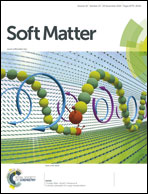The spatial-temporal characteristics of type I collagen-based extracellular matrix†
Abstract
Type I collagen abounds in mammalian extracellular matrix (ECM) and is crucial to many biophysical processes. While previous studies have mostly focused on bulk averaged properties, here we provide a comprehensive and quantitative spatial-temporal characterization of the microstructure of type I collagen-based ECM as the gelation temperature varies. The structural characteristics including the density and nematic correlation functions are obtained by analyzing confocal images of collagen gels prepared at a wide range of gelation temperatures (from 16 °C to 36 °C). As temperature increases, the gel microstructure varies from a “bundled” network with strong orientational correlation between the fibers to an isotropic homogeneous network with no significant orientational correlation, as manifested by the decaying of length scales in the correlation functions. We develop a kinetic Monte-Carlo collagen growth model to better understand how ECM microstructure depends on various environmental or kinetic factors. We show that the nucleation rate, growth rate, and an effective hydrodynamic alignment of collagen fibers fully determines the spatiotemporal fluctuations of the density and orientational order of collagen gel microstructure. Also the temperature dependence of the growth rate and nucleation rate follow the prediction of classical nucleation theory.


 Please wait while we load your content...
Please wait while we load your content...